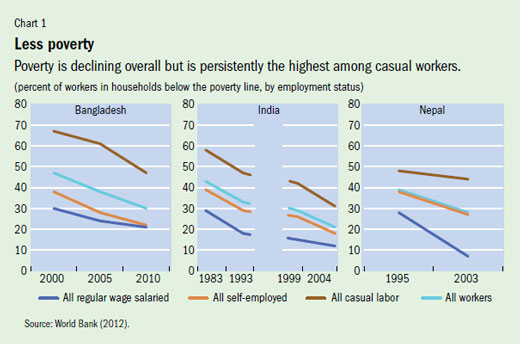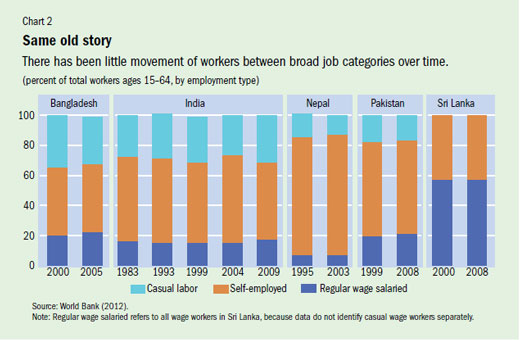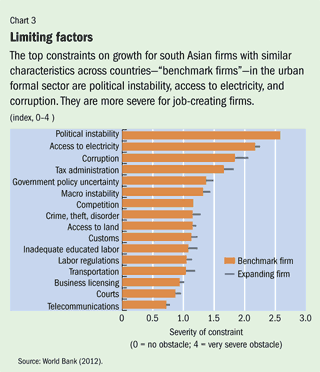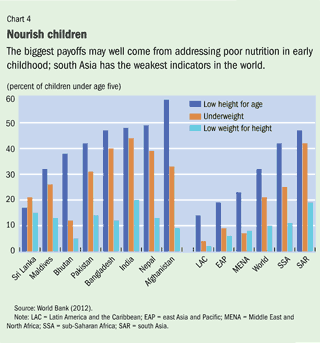More Jobs, Better Jobs
Finance & Development, June 2012, Vol. 49, No. 2
Kalpana Kochhar, Pradeep Mitra, and Reema Nayar
A rapid increase in south Asia’s labor force calls for cross-sectoral policy reforms to support continued growth of high-quality jobs

SOUTH Asia has added nearly 10 million people a year to its labor force for the past decade, while increasing wages and reducing poverty. Both the quantity and quality of jobs have improved. But the employment challenge for the next two decades is more difficult than in the two preceding ones.
South Asia—the Islamic Republic of Afghanistan, Bangladesh, Bhutan, India, Maldives, Nepal, Pakistan, and Sri Lanka—will account for 40 percent of the growth in the world’s working-age (15–64) population until 2050. The region’s employment policies are therefore of global importance. South Asia needs to add new jobs, and better jobs—jobs that increase real wages and reduce poverty.
Track record
Employment growth in south Asia has broadly paralleled growth in the working-age population. Indeed, the ranking of five large countries in the region in descending order of employment growth—Pakistan, Nepal, Bangladesh, India, and Sri Lanka—coincides with their ranking by growth of the working-age population.
Not only have jobs increased in numbers, but their quality has improved as well. The two criteria used to assess job quality are poverty among the self-employed (employers, independent workers, and unpaid family workers) and real wages for wage workers. Wage workers include casual laborers—who are paid on a daily, irregular, or piece-rate basis—and regular wage or salary earners, who receive a regular payment from a job in the public or private sector and usually earn leave and supplementary benefits. Poverty in south Asia has declined among the self-employed (see Chart 1). At the same time, real wages have increased for casual wage workers and regular wage earners. Poverty rates have fallen for wage workers as well.

The composition of the labor force among these three broad employment types has shown little change over time, however (see Chart 2). Self-employed people comprise the largest share, reflecting the predominance of agriculture in much of the region. Casual laborers are next. Although poverty has fallen for each employment type, it is persistently highest for casual laborers and lowest for regular wage or salary workers.

Thus, improvements in job quality have occurred predominantly within each broad employment type rather than through movement across types. But there is movement at the level of individual workers. In rural Bangladesh, India, and Nepal, for example, education facilitates a transition from agriculture to better jobs in industry and services in the nonfarm economy, whereas a lack of education makes a move from the nonfarm economy to agriculture more likely. Indeed, in rural India, for example, workers with lower levels of education are about three times as likely to lose nonfarm jobs as they are to secure them.
Improvements in job quality are primarily due to growth in GDP, with variations across countries. Growth has broadly increased in Bangladesh, India, and Sri Lanka over the past several decades. While growth in Pakistan has trended downward in recent decades, it has been volatile, with a sharp upswing between the 1990s and the 2000s. Job quality in slow-growing Nepal has improved due to massive outmigration of labor from the country, which pushed real wages higher for those remaining, while a flood of workers’ remittances—estimated at a quarter of GDP—accounted for half of the decline in the poverty rate.
Much of the growth in GDP per worker in south Asia that underlies these favorable developments is due more to rapid growth in total factor productivity—a combination of changes in the efficiency with which inputs are used and changes in technology—than to growth in physical capital per worker and education. Looking ahead, while growth in total factor productivity will continue to play a major role, higher rates of physical and human capital accumulation will be necessary to absorb new entrants into the labor force.
Steep climb ahead
Absorbing south Asia’s growing labor force will require adding 12 million jobs every year between 2010 and 2030. And if rates of female participation in the labor markets of the region’s three largest countries (Bangladesh, India, Pakistan)—currently among the lowest in the developing world—increase as they have in some east Asian countries, that figure rises to nearly 15 million jobs, the equivalent of adding the population of Jakarta every year. These additions would be 20 to 50 percent higher than the annual increase between 1990 and 2010.
These entrants into the labor force could be absorbed in jobs producing progressively lower output per worker in low- and lower-middle-income countries, where the absence of safety nets precludes open unemployment. Other things being equal, the more new entrants, the lower the output per worker of the additional jobs created to absorb them.
But the region’s employment challenge is to create jobs at higher levels of output per worker. This calls for accelerated movement of labor out of agriculture and into industry and services, where output per worker is higher—as was the case in east Asia during its years of high growth—as well as moving labor from lower-productivity to higher-productivity firms within industry and services.
While continued high growth is desirable, it cannot necessarily be relied on to meet this employment challenge. International experience suggests that it is a lot harder to sustain high growth than ignite it. Structural reforms will thus be necessary on both the demand and supply sides of the labor market.
Population growth will swell the numbers entering the labor force. But the age composition of that growth has the potential to mitigate the employment challenge. The “demographic transition”—the period during which the number of working-age people grows more rapidly than that of their dependents—can provide a tailwind in support of policy reform for the next two to three decades in much of south Asia. The resources saved as a result of fewer dependents provide a “demographic dividend.” This dividend can be used for the high-priority physical and human capital investments necessary to create better jobs. But harnessing the dividend requires a business environment conducive to factor accumulation so that the potential savings can be turned into actual investments. Because it takes time for policies to have an impact and the demographic window is expected to close around 2040 for most of south Asia, giving way to old-age dependency, strengthening policy reforms is particularly urgent.
Constraints on job growth

Ask managers of south Asian urban formal sector firms that have created jobs to list the top three constraints on their ability to operate and grow. Despite the diversity of the region, they will answer, “electricity, corruption, and political instability.” The constraints are typically more severe for a firm that has expanded employment—which puts more demands on, for example, the electricity supply, roads, the judiciary, and other dimensions of the business environment—than for a firm that has not increased hiring (see Chart 3).
Electricity constraints in some south Asian countries, such as Afghanistan, Bangladesh, and Nepal, are higher than those faced by similar firms (in size, sector, location, nature of ownership, and degree of international engagement) in countries with similar income levels elsewhere in the developing world. During 2000–10, virtually 100 percent of firms in these countries experienced power outages every month. Companies cope by using generators to mitigate the effects of uncertain power supply—a costly solution that is more common in south Asia than in countries with similar income levels elsewhere. Electricity access is also among the top constraints reported by rural industry and service firms in Bangladesh, Pakistan, and Sri Lanka and by urban informal sector firms in India.
Another constraint ranked high by firms is corruption in dealings between firms and the government. Bribes and the amount of time managers must spend with officials from the public utilities or tax administration raise the cost of doing business. Political instability, particularly in countries in conflict or during and after conflict is another constraint on firm operations.
Addressing problems in the power sector is a clear priority. Reforms require public and private investment—which is ongoing—to reduce the large gap between demand and supply, together with tariff adjustments, improved tariff collection, and enhanced capacity and regulatory agency independence to improve the financial and commercial viability of the power utilities. Improvements in the governance of the utilities are equally important.
Early intervention
Another priority for all south Asian countries is to improve the quality of learning at all levels of education and impart the analytical and behavioral skills that employers demand of graduates—which they currently lack. But the greatest human capital investment payoffs may well come from interventions before children begin formal schooling.

South Asia has the world’s highest rates of malnutrition for children under age five—even higher than in sub-Saharan Africa (see Chart 4)—and some of the highest levels of anemia and iodine deficiency. And there is considerable evidence, including from south Asia, that improved nutrition enhances lifetime learning and labor market productivity. Income growth alone will not prevent malnutrition. Early childhood interventions must address nutrition, hygiene, early cognitive stimulation, and effective preschool programs for the disadvantaged if irreversible cognitive impairment is to be prevented.
Although there are some promising pilot early childhood intervention programs, there are very few large-scale programs in south Asia. Establishing these programs would improve the prospects for children’s success in school and, eventually, in the labor market.
Hiring and firing
Employers in formal sector manufacturing in India are much more likely to adjust their workforce by creating and eliminating jobs for nonpermanent contract workers than for regular wage and salary earners. Indeed, the sum of job creation rates (jobs created during a year divided by average employment during the year) and job destruction rates (jobs lost during a year divided by average employment during the year) for contract workers in large manufacturing firms in India is twice as high as for regular workers. This is partly due to labor regulations, which managers in India and their counterparts in Nepal and Sri Lanka report as a significantly more severe constraint on the operation and growth of their business than do similar firms (in terms of size, sector, location, nature of ownership, and degree of international engagement) in countries with comparable per capita incomes.
The high cost of dismissing regular workers is, in effect, a tax on hiring them. Reforms to encourage job creation in the formal economy should lower these costs, which protect only a minority of workers. Such reforms should go hand in hand with those that help all workers—in both the formal and informal sectors—adjust to labor market shocks and improve their future earning potential. Reforms include income support in the event of unemployment complemented by active labor market programs, including cost-effective training and employment services. Building incrementally on existing programs, especially for the informal sector, is likely the best way to proceed.
Investing in jobs
South Asia has created many jobs, including higher-quality ones. It is the quality of jobs that is more important, because the quantity has grown broadly in line with the working-age population.
South Asia’s employment challenge—absorbing a labor force that could be 20 to 50 percent bigger in the next 20 years than in the previous 20 and doing so with rising levels of output per worker—requires moving workers more rapidly, both from farms to industry and services and from lower- into higher-productivity jobs within industry and services. This calls for investment in physical capital: in electricity, for example, where an unreliable power supply hinders the growth of job-creating firms. But it also demands investment in human capital. Equipping a worker to move out of agriculture requires education and acquisition of skills demanded by employers.
Such investment depends on wide-ranging policy changes to facilitate investment in electricity, increase the reach and quality of education, and reduce the cost of hiring and firing workers. The conditions these reforms foster are important for job creation anywhere. But they are even more urgent in south Asia. The demographic transition may provide a favorable tailwind, but it won’t blow forever, and policies take time to bear fruit. ■


